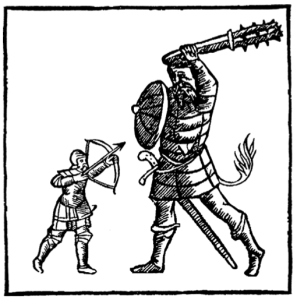Because I am tentatively planning to run a Google Plus hangout game of Pits & Perils this friday, I was reviewing the rules. While doing this, it occurred to me that it might be useful to summarize the aspects that differ from “how things are usually done.”
As a player familiar with traditional fantasy roleplaying games but new to Pits & Perils, I think these are the most obvious differences.
- PCs have 1 or 2 abilities. As in, you “have strength” (no numbers).
- Abilities constrain what you can do.
- To attack, roll 2d6. 9-11 = 1 damage. 12 = 2 damage.
- Fighters get +1 to attack. Magic weapons grant bonuses here also.
- Saving throws succeed on 7+ rolling 2d6.
- Using an ability (for example, dexterity) works like a saving throw.
- Encumbrance is armor & shield + 10 more items (hard limit).
- HP is static (for example, a 3rd level fighter has 14 HP).
- Armor works by adding a small amount of HP.
- Casting a spell costs one spell point (no preparation).
Also, here’s a list of the core spells with numbers, in case you want to determine starting spells randomly (break out that d24). Or click here for a popup.
- Bolt
- Call
- Calm
- Cure
- Fade
- Fear
- Find
- Foil
- Gaze
- Glow
- Heal
- Hide
- Know
- Link
- Load
- Mend
- Mute
- Null
- Pass
- Rise
- Ruin
- Send
- Stun
- Ward


I have such an amazing respect for pits & perils & bucklers & backswords. I wrote about 80% of a pirate game setting for the system before losing interest. Great game. Great great game.
Does the system require the game master to make up target numbers for success?
@Random Wizard
No, in general success is absolute. Attacking with 9+ always inflicts damage, for example.
That said, the text does leave space (and give some guidelines for) common modifiers. So actually there are difficulty classes, but they are downplayed and only come up rarely. Some examples below, from the rules for saving throws and skill-type actions. Quoting:
SAVING DICE
Characters roll saving dice to resist the effects of disease and poison or to escape from traps. This requires 7 or better on 2d6, although dwarves get better saves than other characters (+1/+2 against mechanical traps). Of course, the referee can apply additional bonuses and/or penalties.
NON-COMBAT ACTIONS
Like everything else, players must roll when using their abilities. For instance, climbing walls (dexterity) or lifting gates (strength). Normally, this requires 7 or better on 2d6 (50/50 odds), subject to modifiers for difficulty and/or circumstances. For example, climbing a slippery wall at -1.
The greatest number of characters will have Wisdom as their ability. That seems odd to me, so I came up with an alternative.
Roll one D6. Their ability is:
1-Strength
2-Intelligence
3-Dexterity
4-wisdom
5-Constitution
6-Charisma
Roll the die again- if they get the same number, the player gets to choose an additional ability; otherwise they just have the one originally rolled ability.
@StuRat
That’s a good point. I think I like the flat d6 method better as well. (It also means you can get rid of a lookup table.)